Tips for spotting fake sourdough bread at the store so you don’t waste your money on a phony product that is an unhealthy choice.
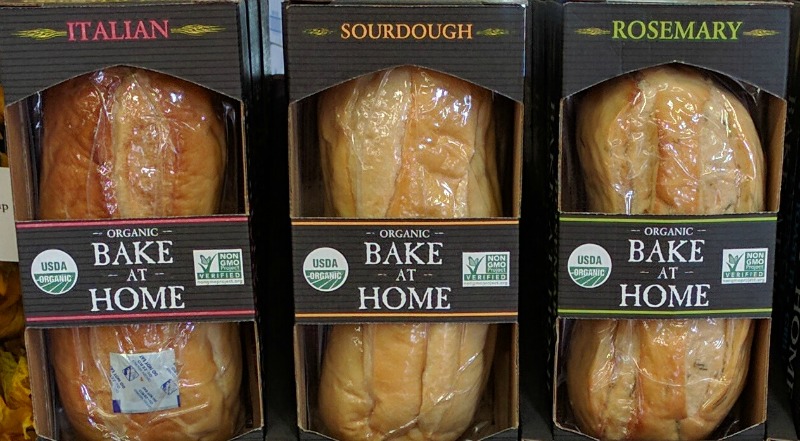
As awareness of the benefits of sourdough bread increases, so does the potential for food manufacturers – both large and small – to exploit the term.
And exploit it they most certainly do!
I recently examined every single loaf of bread at a local health food store. I found only one out of over half a dozen that claimed to be “sourdough” that was leavened in a traditional manner. No, it wasn’t The Essential Baking Company sourdough bread in the picture above. You won’t believe what this company is doing to fool consumers. Even I was shocked, and I thought I had seen it all.
If you choose to buy instead of making sourdough bread yourself (yes, it is a bit time-consuming!), then be on the lookout for fake sourdough!
It is literally everywhere!
Spotting phony sourdough is a more difficult process than you might think due in part to the sourdough myths that seem to abound.
When I first set out to write this article, I thought it would be fairly straightforward to explain. As it turns out, spotting a fake sourdough is rather tricky due to unethical food manufacturer tactics that are far sneakier and devious than I ever imagined.
You really need to be on your toes when sourcing sourdough bread to ensure that you aren’t wasting your money on a product you thought was a healthy choice for your family, but in fact, was quite the opposite.
If you use reading glasses, be sure to always bring a pair with you into the store so you can read the fine print on the packaging. If you wait until you get home to take a look, chances are you are going to be disappointed.
Fake Sourdough Masquerading as Real
The picture above shows one of the most popular fake sourdoughs on the market as of this writing. I was asked to take a look at it by a reader who thought it was legit. This brand is available at many health food stores. At my local Whole Foods, it is very prominently placed with an attractive display right near the checkout lines.
Some folks have notified me that it is also available at Sam’s Club and Walmart mega-supermarkets too!
Notice how the company has taken great care to appeal in every way to the health-conscious, time-challenged consumers:
- The loaf is clearly labeled “Sourdough”.
- The USDA Organic certification is front and center on the box.
- The NonGMO Verified label is prominently shown.
- The term “Bake at Home” is used to catch the eye of time-strapped consumers, some of whom WANT to provide fresh-baked sourdough for their family, but just don’t have the time.
I give this label a 10 out of 10. Fantastic marketing that is sure to move those boxes off the shelf like hotcakes. It’s even priced like a real sourdough would be at $6+/loaf where I live.
Watch Out for Ingredients Listed on the Box vs Online
Here’s the sneaky part. The ingredients on the label of this phony sourdough are DIFFERENT than what is on the website. Yes, the company has obviously done its research. Consumers are increasingly checking out products online before buying.
Don’t fall for this trick. Below is an online screengrab from December 28, 2016, of the ingredients for this company’s “sourdough” bread:
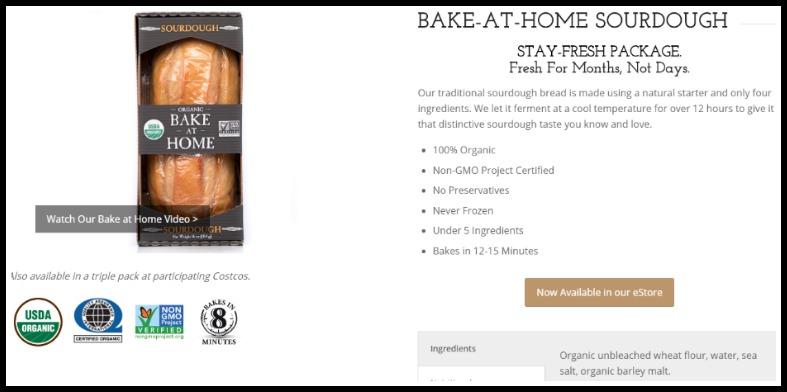
Notice the ingredients say: organic unbleached wheat flour, water, sea salt, organic barley malt.
To semi-researched consumers who know enough about sourdough bread to understand that it never contains yeast, this is enough information to fool them and get them to buy.
Take care not to be easily fooled, however! Look what I found when I looked at the actual label of this very same sourdough bread at the store. Check out the photo below taken on the very same date – December 28, 2016.
The exact same sourdough bread has YEAST listed on the box!
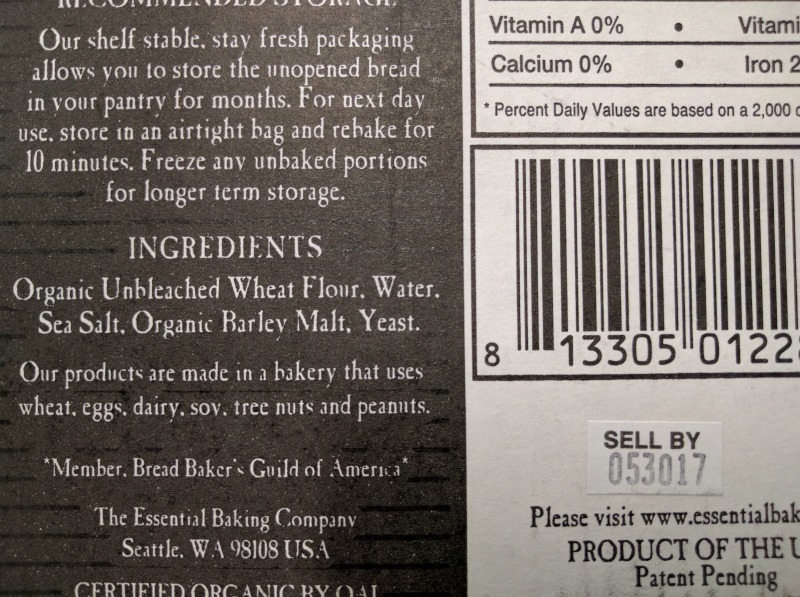
This is a new tactic I have not been aware of before … listing different ingredients for a product online versus what is on the label. Online it states “under five ingredients” using a “natural starter” with the bread “fermented” at a cool temperature for over 12 hours. The box at the store, however, lists 5 ingredients and the “natural starter” turns out to be yeast, which is most decidedly unnatural when it comes to sourdough! Other problems with this bread include the use of sweetener (organic barley malt) and white flour.
If a product seems too good to be true, it probably is.
I mean, seriously? Would an authentic sourdough come in a convenient “bake at home in 12-15 minutes” package that is shelf-stable for nearly 6 months?
Absolutely not!
The short video below summarizes the issues and how to spot the good stuff.
Authentic Labels
The label of true sourdough bread is going to list sourdough starter instead of yeast in the list of ingredients. For example, the gluten-free sourdough bread I buy from a local bakery has “cultured brown rice flour” listed as the starter.
The wording for the sourdough starter varies from brand to brand.
However, there will usually be some indication of a cultured starter as the leavening agent.
This starter contains natural beneficial yeasts from the environment rather than processed baker’s yeast which increases baking speed and baking temperature.
This is important because naturally leavened bread is more digestible, nutritious and less likely to trigger allergy problems than modern, yeast rise bread.
Ultimately, the consumer really must take the time to ensure that the sourdough bread of their choosing really is what it claims.
The Sourdough Bread I Buy
Real sourdough bread is so difficult to find that I’ve resorted to shipping freshly baked sourdough direct from the bakery to my door.
The bakery I use is Organic Bread of Heaven and I order the Rustic Sourdough. I ship in six loaves at a time and freeze what I won’t use in 4-5 days. They also have sourdough bagels, tortillas, hamburger buns, and English muffins among other authentic items.
Free shipping is available for orders over $49 (ask a friend to jump in with you!). The price is several dollars cheaper per loaf than the bread at the health food store.
To give it a try, use coupon HEALTHYHOME (all caps) for 10% off your first order.
Even if you pay shipping by ordering just a few real sourdough loaves, the price per loaf is still comparable to the fake sourdough at the health food store!
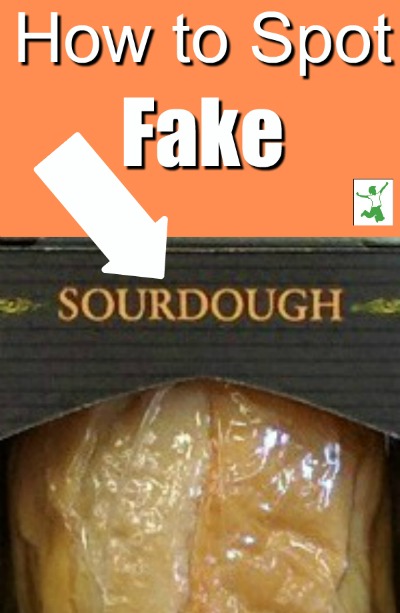
Rules of Thumb
Here are some rules of thumb to identify authentic sourdough bread:
- A handful of ingredients
- No yeast
- Cultured flour starter
- No sweetener
- Made using whole grain flour
- The dough ferments before baking for at least 4-6 hours
After examining the label, if you are still unsure, make a phone call or email to the company. Ask how long the sourdough is allowed to rise (double in size) before baking.
A true sourdough is going to rise for a minimum of about 4-6 hours and even as long as 10-15 hours depending on the temperature.
No baker’s yeast is needed. In addition, no sweetener should appear on the label.
Fake Sourdough At Panera
Be aware that Panera markets its sourdough as real when it is fake too.
Longtime reader Beth S. sent me this email from Panera customer support when she inquired about the authenticity of its sourdough bread. Beth gave her permission to reprint this email.
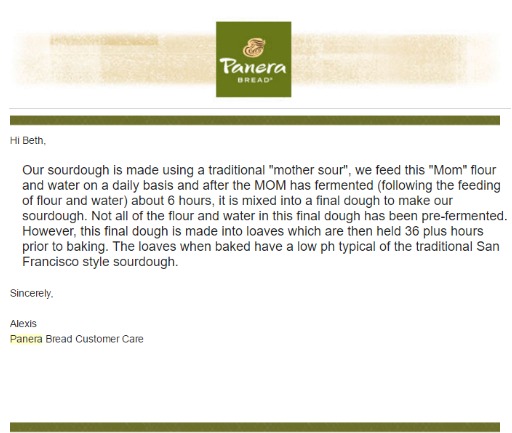
While this answer sounds promising, examining the ingredients of Panera Bread’s sourdough quickly identifies it as a fake. From the Panera website:
Unbleached Enriched Wheat Flour (Flour, Malted Barley Flour, Niacin, Reduced Iron, Thiamine Mononitrate, Riboflavin, [synthetic] Folic Acid), Water, Salt, Yeast (Yeast, Sorbitan Monostearate, Ascorbic Acid [GMO]), Dough Conditioner (Ascorbic Acid [GMO], Microcrystalline Cellulose [refined wood pulp], Corn Starch [GMO])
Not only is the Panera sourdough a phony, but it also contains yeast, wood pulp, and GMOs. It is also fortified with synthetic vitamins including dangerous folic acid (instead of natural folate).
At least The Essential Baking Company’s fake sourdough described earlier in this article is organic. This means no GMOs or other toxic ingredients.
As you can see, the phony sourdoughs on the market today range from simply misleading to downright dangerous. Best to avoid them all and get the real thing!
Do you currently buy an authentic sourdough? If so, what are the ingredients and what is the brand?
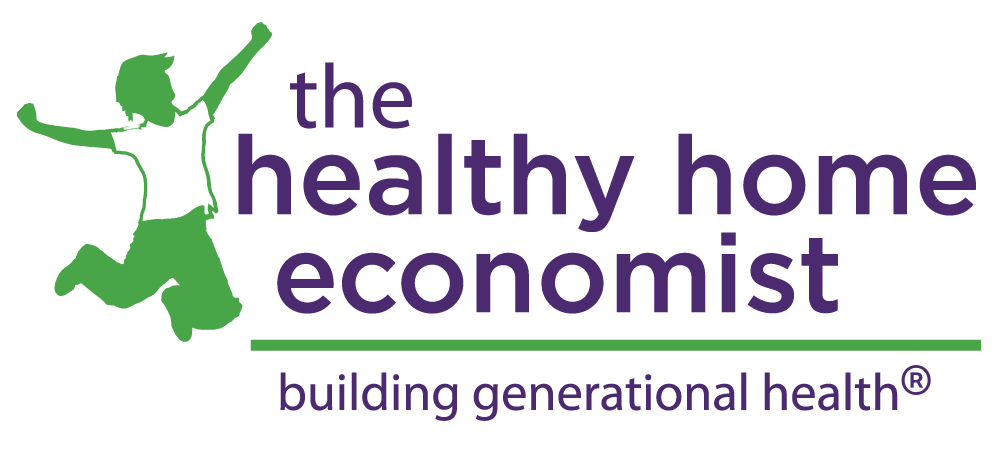







You do realize that sourdough starter is basically a yeast/bacteria culture, right?
Of course! Using this type of starter with natural yeasts and probiotic bacteria to slowly and naturally bake/rise a loaf is quite different from using baker’s yeast for a quick rise fake modern sourdough!
Awesome! Thank you so much for your help :)))
PLEASE HELP… I am confused… I have access to 4 sourdough breads at my local bakery, all with organic ingredient, but which is real sour dough? Here are the ingredients:
#1. Unbleached Wheat Flour (Organic Malted Barley Flour), Water, Organic Whole Wheat Flour and Sea Salt
So is the above a fake sourdough because it uses malted barley flour????
#2. Sourdough Batard – whole wheat starter, all purpose flour, water, sea salt
Does all purpose flour make this fake sourdough
#3. Whole wheat levan – whole wheat starter, 100% whole wheat flour, water, sea salt
I’m thinking this is the real sourdough.
#4. German rye – whole wheat starter, rye flour 80% and 20% all purpose flour, water sea salt
Again this one contains all purpose and not sure if that makes is fake sourdough.
Sorry if this is a repeat I can’t remember if I hit post comment the first time.
Thank you for your help,
Betsy
Options 2, 3 and 4 are all true sourdough, but option 3 would be best as no all purpose flour is used.
Question: so if I have a starter given to me by a friend and make the sourdough bread regularly myself but to feed the starter requires sugar, potato flakes and warm wate and then the bread recipe itself has sugar in it, it doesn’t have the same health benefits as a starter that requires only flour and water to feed it? Quite obviously white sugar isn’t ideal, but in this recipe it’s required to feed the starter…
That is not true sourdough unfortunately.
Sara, you say don’t buy sour dough bread that contains yeast but do not say where we can get REAL sour dough. I live in Knoxville, TN and have been to all bakery’s I can find and all list yeast and do not have time to make my own. Any suggestions?
If you contact the Weston Price Foundation, westonaprice.org, they offer an annually updated Shopping Guide that lists plenty of vendors for authentic sourdough that will ship to your door if not available locally.
Sarah, why do you consider a sourdough bread made with white flour non-sourdough? The sourdough process comes through the starter fermenting the dough and breaking down phytic acid to create a more digestible loaf. Most folks would say that authentic sourdough bread comes from the starter and the fermentation process, not the flour used. There is whole grain sourdough and white sourdough. One may be more nutritious than the other, but both would be considered authentic sourdough if the starter and process used to ferment the dough were the same. Again, just starter, flour, water and salt as the ingredients.
Because a true, authentic traditional sourdough is made with whole grain flour. Refined white flour is not healthy and is a “displacing food of modern commerce” (quoting Dr. Weston Price).
Scary article about citric acid. I had to give up sour dough these past few months, because I was having autoimmune reaction to it. Now I know why!
No. Yeast is not listed as an ingredient in sourdough bread.. Making an incredibly delicious hearty healthy loaf of bread requires nothing more than wheat and water and the knowledge and skill of bakers (we add a small amount of salt but even though it’s recommended, it’s not required). And we never add yeast to our dough or to the starter. Wheat comes with wild yeast that adheres to the grain from the field. When we sprout wheat and grind it into a mash, that wild yeast “activates” as it feasts on the sugars contained in the endosperm. This food source also attracts yeast that is ever present everywhere – in the air, on our hands, etc. So in that sense, every baker’s sourdough is very much a unique product to that baker but not entirely. Further, sourdough is more than just wild yeast. This same food source attracts a multitude of beneficial bacteria and this interplay of bacteria and fungus or wild yeast within the sourdough is what promotes fermentation. Again, we don’t add bacteria, it finds it’s own way into the ferment. But if I have to list yeast as an ingredient, wouldn’t I also have to list lactobacilli and bifida-bacteria…? I don’t and I’ve never seen those items listed in any sourdough bread I’ve ever seen and yet, without them, you have no ferment (sourdough).
I must make a comment regarding this article regarding yeast on a label being a sign of “fake” sourdogh. Sourdough contains yeast by definition. I have been a baker for 40 years and can tell you that yeast is a required ingredient in sourdough bread. Sourdough starter is a yeast culture most often composed of yeast, flour & water( there can be some variation but there has to be yeast) with the starter being nurtured as a living thing and fed regularly. Over time as the yeast consumes the starches in the flour the sour flavour is created with the strength of the flavour varying according to the strain of yeast, which can be a known yeast like the yeast in San Francisco Sourdough or a wild yeast that has been captured & grown. Yeast also provides all the leavening for the bread but for sourdough there should be no more yeast added beyond what is in the starter.
Further in many jurisdictions the bakery is required to list all ingredients. Simply listing sourdough starter doesn’t make the grade as an ingredient. When all ingredients are required you must list all ingredients including the components of your starter, as I said, usually flour, water and yeast.
Thank you Sarah. This is the only article I could find online that actually talked me through the process of determining for myself what real sourdough is and should look like – as far as reading food labels go. And for the record Darrell, this author is most certainly not one bit misinformed. You seem to be. We all know the refining process removes fiber along with most vitamins and minerals.. without question, whole grains are nutritionally superior to refined grains. This is already well known, and therefore not necessarily the topic of this article. Commercial or “Baker’s Yeast” also diminishes most if not all of the grains nutritional value and acts so fast (for convenience and profitability) that little if any fermentation actually takes place. Please do your research before trying to discredit someone. We need more Sarah’s out there if we stand a chance at reversing the detrimental effects of industrial agriculture on our bodies and the environment.